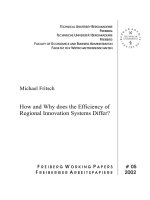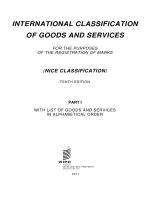How and Why does the Efficiency of Regional Innovation Systems Differ? doc
Bạn đang xem bản rút gọn của tài liệu. Xem và tải ngay bản đầy đủ của tài liệu tại đây (638.8 KB, 26 trang )
TECHNICAL UNIVERSITY BERGAKADEMIE
FREIBERG
TECHNISCHE UNIVERSITÄT BERGAKADEMIE
FREIBERG
FACULTY OF ECONOMICS AND BUSINESS ADMINISTRATION
FAKULTÄT FÜ R WIRTSCHAFTSWISSENSCHAFTEN
Michael Fritsch
How and Why does the Efficiency of
Regional Innovation Systems Differ?
F
R E I B E R G
W
O R K I N G
P
A P E R S
F
R E I B E R G E R
A
R B E I T S P A P I E R E
# 05
2002
The Faculty of Economics and Business Administration is an institution for teaching and
research at the Technical University Bergakademie Freiberg (Saxony). For more detailed
information about research and educational activities see our homepage in the World Wide
Web (WWW):
Address for correspondence:
Prof. Dr. Michael Fritsch
Technical University Bergakademie Freiberg
Faculty of Economics and Business Administration
Lessingstraße 45, D-09596 Freiberg
Phone: ++49 / 3731 / 39 24 39
Fax: ++49 / 3731 / 39 36 90
E-mail:
Revised version of a paper prepared for presentation at the International Workshop on
“Innovation Clusters and Interregional Competition”, Kiel, November 12./13. 2001
_______________________________________________________________________
ISSN 0949-9970
The Freiberg Working Paper is a copyrighted publication. No part of this publication may
be reproduced, stored in a retrieval system, or transmitted in any form or by any means,
electronic, mechanical, photocopying, recording, translating, or otherwise without prior
permission of the publishers.
All rights reserved.
_______________________________________________________________________
- I -
Contents
1. Introduction 1
2. A review of hypotheses and empirical evidence 1
3. Data 3
4. Interregional differences with regard to innovation input and
innovation output 5
5. Measuring the efficiency of regional innovation activities 9
6. Can cooperation behavior explain differences of R&D efficiency? 14
7. Concluding remarks 19
References 20
- II -
Abstract
Literature suggests that location should matter for R&D activities. However,
attempts to empirically detect differences in innovation activity between
regions have so far been rather unsuccessful. Using a unique data set which
contains comparable information about manufacturing enterprises in eleven
European regions, a number of significant regional differences in the efficiency
of innovation activities can be found. This variation is in correspondence with a
center-periphery pattern indicating that agglomeration economies are conducive
to R&D activities. The paper investigates whether the differences in efficiency
of regional innovation systems can be explained by differences in R&D-
cooperation behavior.
JEL classification: D21, L6, O32, R30
Keywords: Innovation, R&D productivity, R&D cooperation, regional
innovation systems, knowledge production function
Zusammenfassung
“Inwiefern und warum sind regionale Innovationssysteme
unterschiedlich effizient?“
In der Literatur finden sich vielfältige Hinweise darauf, dass von den Standort-
bedingungen ein Einfluss auf Innovationsaktivitäten ausgeht. Allerdings haben
entsprechenden empirische Untersuchungen bisher nur recht schwache Evidenz
hierzu erbracht. Auf der Grundlage von Daten über Industriebetriebe in elf eu-
ropäischen Regionen können eine ganze Reihe von signifikanten interregiona-
len Unterschieden hinsichtlich der Effizienz von Innovationsaktivitäten identi-
fiziert werden. Dass diese Unterschiede tendenziell einem Zentrum-Peripherie-
Muster entsprechen deutet darauf hin, dass für FuE-Aktivitäten bestimmte Ag-
glomerationsvorteile bestehen. In dem Aufsatz wird der Frage nachgegangen,
inwieweit die feststellbaren Unterschiede der Effizienz regionaler Innovations-
systeme mit entsprechenden Unterschieden im Kooperationsverhalten erklärt
werden können.
JEL-Klassifikation: D21, L6, O32, R30
Schlagworte: Innovation, FuE Produktivität, FuE Kooperation,
Regionale Innovationssysteme,
Wissensproduktionsfunktion
- 1 -
1. Introduction
The question “Do Regions Matter for R&D?” (Kleinknecht and Poot,
1992) has a long tradition in the regional economics literature. While a number
of hypotheses suggest that location has a strong impact on innovation activity,
the available empirical evidence is not at all persuasive (Section 2). This paper
investigates differences in innovation behavior in a sample of eleven European
regions (Section 3). The analysis reveals a number of differences in the input
and output of innovation processes (Section 4). Regions also differ with regard
to the efficiency or productivity of innovation activities that can be considered
indicate the quality of a regional innovation system (Section 5). Based on such
efficiency estimates, which are derived from a knowledge production function,
the question is whether the interregional differences can be explained by R&D
cooperation behavior (Section 6). Section 7 contains some final remarks.
2. A review of hypotheses and empirical evidence
According to a widely accepted hypothesis, the level as well as the
success or efficiency of innovation activity should be higher in easily accessible
locations, i.e., densely-populated regions – the center – than in more remote
areas or regions that are characterized by a relatively low degree of
agglomeration – the periphery (for a brief review of the literature see Fritsch,
2000, 410f.).
1
Two main reasons for such a geographical pattern are given in
the literature. First, spatial clustering of innovation activities of a certain type or
in a certain technological field is in many cases associated with a well-
developed regional supply of needed inputs. Among these are differentiated
markets for labor and innovation-related services, the presence of institutions
(e.g., universities) whose research activities focus on the particular
1
In a broad sense, a region in the ‘center’ may be defined as an easily accessible location
characterized by relatively high density of population and economic activity. A center has a
relatively high rank in the spatial hierarchy. In contrast, regions in the ‘periphery’ are lacking
these properties. They are characterized by relatively low density, poor accessibility, and rank
relatively low.
- 2 -
technological field as well as the easy availability of relevant information.
Secondly, it is argued that knowledge spillovers generated by innovation
activities are concentrated in the area near the source (cf. Acs, Audretsch and
Feldman, 1992; Anselin, Varga and Acs, 1997; Jaffe, Trajtenberg and
Henderson, 1993). Actors in spatial proximity to many such sources in a cluster
or a densely populated area, therefore, benefit from a higher level of spillover
than actors in regions with a relatively low density of innovation activities or at
a more remote location. Based on these arguments, one may expect innovation
activities to operate at a higher level and with higher productivity at the center
as compared to the periphery. Therefore, a certain degree of agglomeration or
clustering of innovators within a particular area should be conducive to
innovation activities (Baptista and Swann, 1998; Porter, 1998).
A number of empirical investigations concerning the regional distribution
of R&D have indeed shown that innovation activities in a particular
technological field tend to be clustered regionally (Almeida and Kogut, 1997;
Baptista and Swann, 1998, 1999; Feldman, 1994; Audretsch and Feldman,
1996; Porter, 1998). However, there is nearly no empirical evidence showing a
significant effect of location on innovation activities of firms or establishments
(for a brief review see Fritsch, 2000). A possible reason for the difficulty in
finding evidence of the interregional differences in innovation activities may be
that a clear measurement concept and appropriate data has been lacking.
Recent attempts to explain the level and the success of regional
innovation activities, such as the network approach
2
or the concept of
‘innovative milieux’
3
, emphasize the role of cooperative relationship between
innovative actors and firms or institutions. According to these approaches, the
availability of inputs and the spatial proximity to other innovators constitutes
only a necessary condition for agglomeration economies to become effective.
Of crucial importance is how the innovative actors make use of these possible
2
Cf. Saxenian (1994) and the contributions in Pyke, Beccatini and Sengenberger (1990),
Camagni (1991) and in Grabher (1993).
- 3 -
advantages, such as by maintaining R&D cooperation and implementing an
effective division of innovative labor. Some regional case studies suggest that
spatial clustering or density of innovation activities does not necessarily lead to
a higher level of cooperation between the firms or research institutions in a
particular region (e.g. Sabel, Herrigel, Deeg and Kazis, 1989; Saxenian, 1994).
Yet, when firms in a region cooperate on R&D, it may have a great effect on
the result of their innovation activities. However, empirical evidence on
regional peculiarities with regard to R&D cooperation is rather poor, based
mainly on the ‘impressions’ the authors received while conducting case studies.
We do not really know the significance of interregional differences in R&D
cooperation behavior. It is, therefore, interesting to ask if significant variations
in R&D-cooperation behavior between regions exist and to what degree such
differences contribute to explain diverging levels and efficiency in innovation
activity.
3. Data
The empirical analyses reported here are based on data gathered from
questionnaires mailed to manufacturing enterprises in eleven European regions
(Figure 1). This survey was done in two phases between 1995 and 1998. It
resulted in a data set consisting of approximately 4,300 usable questionnaires.
The questions concentrated on innovation-related issues, but it also gathered
general information on each enterprise, such as the number of employees, the
amount of turnover, characteristics of the product program, etc. (for a more
detailed description of the data set see Sternberg, 2000).
Four of the eleven regions included in the survey are dominated by large
cities of international importance. These regions are Barcelona, Rotterdam,
Stockholm, and Vienna, with the latter two cities serving as national capitals.
Two of the regions in our sample, Saxony and Slovenia, were under socialist
3
See Crevoisier and Maillat (1991) and the contributions to Aydalot and Keeble (1988).
- 4 -
Figure 1: Case study areas
- 5 -
regime until 1990/1991 and have to a greater or lesser degree had to completely
reorganize their innovation system. Baden, one of the two West German
regions in the sample, is said to have a relatively well-functioning innovation
system (Cooke, 1996; Heidenreich and Krauss, 1998). The other West German
region, Hanover, has a relatively high share of large-scale industries (e.g.,
automobiles, steel) while the proportion of employment in new innovative
industries is comparatively low. The French border region of Alsace, which is
adjacent to the Baden region in Germany, represents a relatively rural area. The
second French region, Gironde, has a significant share of employment in high-
tech industries most of which are well-integrated into the global division of
labor. Finally, South-Wales represents an old industrialized region that has
experienced a considerable employment shift from ‘old’ declining industries to
‘new‘ high-tech industries in recent years (cf. Cooke, 1998). Due to the great
variation in economic development and location conditions of the regions in our
sample, we may expect location to have an impact on R&D. We should then
find such differences in the data.
4
4. Interregional differences with regard to innovation input and
innovation output
Careful analysis of the data has revealed a number of differences with
regard to innovation activities between the regions under examination (see
Fritsch, 2000 for details). Information concerning Barcelona, Rotterdam,
Stockholm, and Vienna, the four regions that are dominated by large urban
areas, is always grouped in the upper part of the tables to make identification of
the special characteristics of these regions easier. Looking at the input to the
innovation process, we find the highest proportion of establishments with R&D
employment in the two metropolitan areas of Barcelona and Rotterdam. Alsace
and South-Wales, two regions characterized by a relatively low population
density, have the lowest share of establishments that perform R&D (Table 1). In
the two regions that are making a transition to a market economy, Saxony and
4
For an overview of economic conditions and innovation activities in the different regions see
Fritsch (2000).
- 6 -
Slovenia, the proportion of establishments with R&D employees was in the
middle range. Using the proportion of R&D employees (including
establishments without R&D) as an indicator of the intensity of R&D activities
in a region, the Saxony again has a middle position while Slovenia is at the
lower end. In all case-study regions, R&D employment increased more than
overall employment (or showed a smaller decline compared to the fall in overall
employment) so that the share of R&D employment rose. The amount of R&D
expenditure per R&D employee was at a relatively low level in Slovenia and
South-Wales. Quite strikingly, the enterprises in Vienna not only had by far the
highest share of R&D employment, but also the highest R&D expenditure per
R&D employee.
Table 1: Indicators for inputs for innovation processes (percentages)
Share of firms
with R&D
employees (%)
Share of R&D
employees (%)
+
Changes in R&D
employment in
preceding 3
years (%)
+
R&D
expenditure per
employee
++
R&D expend-
iture per R&D
employee
++
Barcelona 89.8 6.2 15.2 3.50 62.21
Rotterdam 83.2 5.3 16.9 2.80 56.08
Stockholm 74.6 8.4 21.5 5.29 82.21
Vienna
74.7 10.7 -2.8 4.19 104.21
Alsace 61.1 4.7 7.2 3.56 93.87
Baden 70.2 6.6 0.4 5.00 85.39
Gironde 67.8 4.0 32.6 3.75 72.49
Hanover 77.7 3.7 7.6 4.46 89.84
Saxony 74.9 5.9 -2.5 3.69 53.37
Slovenia 79.4 3.2 -0.7 1.13 32.08
South-Wales 61.2 3.6 49.0 3.10 44.48
Notes:
+
All enterprises;
++
median, thousands ECU per year, innovative enterprises only.
The proportion of manufacturing enterprises that have introduced at least
one significant product or process innovation during the preceding three years
represents a rather broad indicator for the output of innovation activities in a
regional economy. The highest share of innovating establishments according to
this measure is found in Barcelona, followed by South-Wales and Rotterdam
(Table 2). In Saxony and Slovenia, the two regions that are undergoing a
transition from a socialist system to a market economy, the share of innovators
tends to be relatively high, but the figures belie the expectation that there would
- 7 -
be a special urgency to modernize given the backwardness of production
processes and product programs. With the exception of Barcelona, the share of
enterprises with at least one product innovation tends to be higher than the
proportion of enterprises that have implemented at least one process innovation.
The ratio of new products
5
to the total number of products supplied by an
enterprise indicates the amount of product innovation activity. The relatively
high values for this indicator found in Slovenia and Saxony are very likely
caused by the special necessity to modify the products supplied that
accompanies the transition to a market economy (cf., Fritsch and Werker,
1999). Compared to these high shares of new products, the proportion of
turnover that was achieved with the new products (another questionnaire topic)
was relatively low in Saxony and Slovenia. This could indicate that these firms
had particular problems in marketing their product innovations.
Table 2: Indicators for the results of the innovation process
Share of enterprises (%) with at
least one
innovation
process
innovation
product
innovation
Ratio of new
products to
total number of
products (%)
+
Share of
turnover with
new products
(%)
+
Share of enter-
prises that
registered for
patenting in
preceding 3
years (%)
Patents per
enterprise
(mean, enter-
prises with
patents only)
Barcelona 93.5 79.3 79.1 33.3 20 28.9 6.4
Rotterdam 80.2 56.1 64.3 26.5 15 21.9 2.2
Stockholm 72.3 57.8 66.2 25.0 20 27.0 3.8
Vienna
78.9 46.5 56.5 21.4 15 28.0 16.8
Alsace 61.9 53.6 58.6 25.0 20 18.0 4.5
Baden 71.8 65.6 66.6 25.0 30 31.6 8.0
Gironde 65.0 45.0 49.0 21.4 20 15.1 2.6
Hanover 78.2 66.1 75.3 20.0 20 37.7 6.9
Saxony 79.2 66.6 76.5 50.0 40 19.9 3.8
Slovenia 76.4 59.6 70.2 100 25 10.4 2.8
South-Wales 82.0 56.8 74.5 30.0 20 26.3 2.0
Notes:
+
Median, innovative enterprises only.
5
A product was classified as ‘new’ if it was new in the enterprise’s product program. This
relatively broad definition of a new product clearly did not rule out imitation.
- 8 -
The relatively low share of enterprises in Saxony and Slovenia that had
registered at least one invention for patenting in the preceding three years
(Table 2) is probably a result of the special situation in these regions, which
were both formerly under a communist regime. Due to general technological
backwardness, innovation activities in these regions were dominated by the
necessity to catch-up, which merely requires the adoption and imitation of
already existing products and processes. Such catch-up imitations are clearly
excluded from patenting because only something that is completely new is
patentable. The highest proportion of enterprises with registered patents was
found in the two West German regions, Baden and Hanover, followed by the
three large agglomerations of Barcelona, Vienna and Stockholm. We find the
lowest average number of patents per enterprise in Saxony and in South-Wales
(Table 2). By far the highest value for this indicator was attained in Vienna.
Baden and Barcelona also appear to be rather innovative according to this
measure.
All in all, we see a number of strong differences between the regions with
respect to innovation input and innovation output. These differences clearly
suggest that location is important and that regions do matter for R&D.
Remarkably, no indication of a center-periphery pattern in innovation activity
has been found. Because many innovation-related indicators tend to be strongly
influenced by such factors as business size, industry characteristics and other
issues (e.g., affiliation with a multi-plant firm), differences in the values of
innovation indicators for the regions may be caused in large part by differences
in establishment size or industry structure. It could, therefore, be desirable to
control for such influences by means of a multivariate analysis.
6
The results of
such a multivariate analysis measuring the efficiency of regional innovation
activities are presented in the next section.
6
However, as far as those influences that are controlled for in the analysis (e.g., the size
structure and the industry structure in a region) can be interpreted as resulting from location
factors, the effects of size or industry are also (indirectly) generated by regional characteristics.
Therefore, it may be dubious to try to identify the impact of location by controlling for size and
- 9 -
5. Measuring the efficiency of regional innovation activities
Relating innovative output to a measure of R&D input such as the number
of employees or the number of R&D employees, leads to measures that may be
interpreted as indicators of the productivity of innovation activity. In as much
as the R&D productivity of an establishment is determined by factors in the
external environment, these productivity measures may also be regarded as an
indication of the quality, particularly the efficiency and workability of the
national, regional or industry-specific innovation system. The figures for the
average number of new products and patents per employee or per R&D
employee in Table 3 diverge widely. With regard to the number of new
products, the four leading regions are Rotterdam, Gironde, Baden and Saxony,
with Stockholm, Vienna and Hanover ranked at the bottom. As in the previous
parts of this analysis, with regard to the productivity measures reported in Table
3, no clear center-periphery pattern is evident which would indicate relatively
favorable conditions for innovation activities in the urban areas.
Table 3: Indicators for the productivity of the innovation process
Number of new
products per
employee
+
Number of new
products per R&D
employee
+
Number of patents
per employee
++
Number of patents
per R&D
employee
++
Barcelona 0.36 5.80 0.048 0.28
Rotterdam 1.17 19.91 0.023 0.40
Stockholm 0.21 2.33 0.018 0.31
Vienna
0.21 1.84 0.039 0.26
Alsace 0.35 6.47 0.011 0.19
Baden 0.64 8.8 0.034 0.41
Gironde 0.61 12.46 0.026 0.64
Hanover 0.12 2.8 0.017 0.35
Saxony 0.55 9.3 0.029 0.39
Slovenia 0.32 9.88 0.005 0.12
South-Wales 0.36 7.71 0.009 0.71
Notes:
+
Mean, innovative enterprises only;
++
mean, enterprises with patents only.
industry structure because such a strategy neglects the indirect effects of location on the
economic structure of a region.
- 10 -
A rather sophisticated assessment of R&D productivity can be made by
estimating the output elasticity of innovative input in the framework of a
knowledge production function for the different regions. Output elasticity can
serve as an overall measure of the quality of a regional innovation system. The
main advantage of this approach is that the inclusion of certain control variables
provides a simple way of accounting for industry structure and other region-
specific factors (see Fritsch, 2002a for a detailed exposition). The basic
assumption underlying the concept of the knowledge production function is that
the output of the innovation process represents a result of R&D capital or
investment. Taking the Cobb-Douglas production function as a framework, the
basic relationship is
(1) R&D output = a R&D input
b
,
with the term a representing a constant factor and b giving the elasticity by
which R&D output varies in relation to the input to the R&D process. If the
elasticity value equals one, a 100 percent increase in R&D expenditure would
lead to a doubling of innovative output. An elasticity value lower than one
indicates that innovative output does not rise in proportion to R&D input. The
elasticity should increase as the quality of inputs to the R&D process improves
and the spillovers stemming from the R&D activities of other actors in the
region become more pronounced. The output elasticity is dimensionless, and
therefore is not affected by price level differences in the regions or by
exchange rates in the case of an international comparison if the input and/or
output to the innovation process is measured in monetary terms.
The key input factor to this process, knowledge, tends to be cumulative in
character, so that innovation is based on a stock of knowledge capital. In
practice, this knowledge stock can be measured only incompletely. The best
that we might know is the R&D effort, i.e. the investment into the knowledge
stock within a certain time period that may not cover all the relevant flows. In
many data sets available for an empirical analysis of innovation activities, we
cannot be entirely sure if R&D investment is properly defined and if it relates to
- 11 -
that part of the knowledge stock which was relevant for the innovation output
being measured. In particular, information about an R&D investment which
was made long ago is hard to obtain. However, under the assumption that
innovation effort is fairly constant over time, an incompletely measured R&D
input may serve as a good proxy for knowledge capital.
In the estimates presented here (Table 4), the indicator used for R&D
output was the number of inventions registered for patenting during the
preceding three years. To avoid problems of having ‘too many’ zero-values in
the model
7
, estimates were made only for those enterprises that had registered
at least one invention for patenting during the preceding three years. A patent is
granted for a significant invention that is new on a world-wide scale. For this
reason, including only establishments with patent applications in the sample
implies that the estimations are based solely on information from enterprises
which are performing near the technological frontier. This approach has the
great advantage that the output of the innovation process is somewhat
standardized, and that innovation processes of about the same level of novelty
are compared. Because R&D expenditure includes inputs to the R&D process
that are purchased from other establishments, it is a more comprehensive
measure than the number of R&D personnel. Six dummies-variables are used to
control for the influence of the different industries which the establishments
belong to. Interregional differences were investigated by including two types of
regional dummy-variables.
8
Dichotomous variables having the value 1 if the
respective establishment was located in a certain region and the value 0
otherwise, indicated differences with regard to the constant term of the
knowledge production function.
9
The coefficients for an interaction of these
7
A distribution of observations that is characterized by a relatively large number of cases at
one end violates basic assumptions underlying most standard estimation procedures.
8
As an alternative approach, the model was estimated for each of the regions separately (see
Fritsch, 2000, 2002a). Because both approaches to estimating regional innovation output
elasticities with regard to R&D input lead to quite similar results (cf. Fritsch, 2002a), only the
estimates derived from a knowledge production function for all regions are reported here
9
The interpretation of estimates for the constant term of the knowledge production function is
somewhat problematic. If the number of innovations is used as indicator for the success of R&D
activities, the constant term denotes how many innovations have been generated without a
- 12 -
dummies with an establishment’s R&D input (R&D expenditure or R&D
employment, respectively) reflect differences of the slope of the knowledge
production function pointing to diverging output elasticity or productivity of
innovation processes. Baden is taken as the reference region for testing
statistical significance of differences found.
Table 4: Regional dummy variables for the output elasticity of R&D input estimated in the
framework of a knowledge production functions – results of negative binomial
regressions with output measured as number of patents
Output elasticity
with respect to
R&D
expenditure
Output elasticity
with respect to
R&D
employment
Barcelona -0.10
(1.11)
-0.20*
(2.20)
Rotterdam -0.07
(0.55)
0.05
(0.36)
Stockholm 0.01
(0.18)
0.14
(1.54)
Vienna 0.20*
(2.10)
0.48**
(4.11)
Alsace -0.07
(0.50)
-0.12
(0.95)
Gironde -0.61**
(5.77)
-0.56**
(3.53)
Hanover -0.12
(1.41)
-0.13
(1.68)
Saxony -0.07
(0.74)
-0.01
(0.09)
Slovenia -0.43**
(3.37)
-0.40**
(2.84)
South-Wales -0.14
(1.15)
0.02
(0.10)
Pseudo R
2
0.134 0.127
N. of cases 705 707
**: Statistically significant at the one-percent level. *: Statistically significant at the five-
percent level. Asymptotic t-values of the coefficient in parentheses.
corresponding R&D input during the period in which R&D input was measured. Assuming that
the generation of an innovation necessitates some R&D input, there are two possible
explanations for the existence of a positive constant term. One possible explanation is that the
respective innovation has resulted completely from knowledge spillovers from other sources,
without any R&D effort on the part of the firm that is supposed to have generated it. In this
case, the constant term of the knowledge production function represents those innovations that
fall like manna from heaven on a certain firm. Another possible explanation concerns the
measurement of the input to the innovation process. A positive constant term of the knowledge
production function may indicate that the innovation was not based on current R&D investment,
but on the existing stock of ‘old’ knowledge, which could not be measured. In this case, the
constant term of the knowledge production function represents an error in specifying the input
variable.
- 13 -
Looking at the estimated dummy-coefficients for divergent regional
output elasticities of R&D input, we find a lot of negative signs indicating a
lower efficiency of innovation activities than in Baden. This confirms many
judgments found in the literature that emphasize relatively good quality of the
innovation system in this region (e.g., Cooke, 1996; Heidenreich and Krauss,
1998; Sabel, Herrigel, Deeg and Kazis, 1989 ). The highest output elasticity is
found for Vienna (cf. Table 4). While the elasticities for Rotterdam and for
Stockholm were not significantly different from the value for Baden (the
reference region), the coefficient for Barcelona estimated on the basis of R&D
employment as input measure indicates a significantly lower productivity than
in Baden. By far, the lowest values for the output elasticity of R&D input are
found for Gironde and Slovenia.
10
For many of the other regions, the dummies
measuring differences of R&D output elasticities have a negative sign,
indicating a lower productivity in R&D activities when compared to Baden.
These differences are not statistically significant, but if a region like Barcelona,
Gironde, or Slovenia is taken as reference, considerably more significant
regional effects are found. The estimates of the regional dummies based on
R&D expenditure differ to some extent from the estimates using R&D
employment as indicator for R&D input, yet, these differences are within
reasonable limits.
On the whole, the results correspond to a center-periphery paradigm. This
suggests that being located in a large agglomeration tends is more conducive to
R&D activities than being located in less densely populated or more peripheral
regions. However, there were also relatively high values of output elasticity in
some less urbanized areas (e.g., Saxony, South-Wales) indicating that R&D
activity may also be conducted productively in these locations. Other measures
for innovation activities point in the same general direction, but the regional
pattern is less clear (cf. Fritsch, 2000). At least there are nothing in the data that
10
However, estimates for these regions are based on relatively few observations, so it might
be argued that they do not reflect the conditions in the respective regions correctly. The number
of usable observations for Gironde was 13 (model with R&D expenditure as input variable) and
- 14 -
indicates that peripheral areas or regions with low population density have a
clear advantage over the centers with regard to R&D.
6. Can cooperation behavior explain differences in R&D efficiency?
The dataset, which provides rich information on R&D cooperation with
different types of partners, was gathered by a number of questions. One sort of
question tried to assess whether or not the given enterprise had maintained
cooperative relationships with a focus on innovation activities with a certain
type of partner in the preceding three years. This particular question was asked
for five types of partners separately: customers, manufacturing suppliers,
suppliers of business services
11
, “other” firms, and publicly-funded research
institutions. The research institutions comprised universities
12
and publicly-
funded non-university research institutions. The “other” firms are non-vertically
related businesses, particularly including competitors. There are clear
indications that most of the relationships to “other” firms were horizontal in
nature. Cooperation with suppliers or customers was defined as a relationship
beyond “normal” business interaction. With regard to “other” firms and
publicly-funded research institutes, all kinds of relationships were assumed to
be cooperative. For each partner type, we know the number of cooperative
relationships within different regional categories (“within the region”, “rest of
the country”, “abroad”).
13
11 enterprises (model with R&D employment as input variable). The estimates for Slovenia
were based on 31 and 35 cases, respectively.
11
The main fields were software development, tax and legal examination, auditing, business
consultancy, market research, advertising, engineering and planning services, check and test
services, architecture, etc. For some of the regions, Alsace, Baden, Hanover and Saxony,
information about cooperative relationships with suppliers of business-oriented services was not
raised in the same way as the information on cooperation with other partner types. Therefore,
relationships with suppliers of business services has been left out in analyses focusing on these
regions (Fritsch and Lukas, 2001; Fritsch, 2001).
12
In Germany, this included the Fachhochschulen (universities with a particular focus on
applied studies in engineering, business and other subject areas).
13
For an overview of the different kinds of cooperative relationship with the different partner
types see Fritsch and Lukas (2001).
- 15 -
Figure 2: The propensity to cooperate in the case study areas
- 16 -
Suppliers of business-oriented services have been most frequently named as a
partner for R&D cooperation. Roughly two thirds (67.3%) of all manufacturing
enterprises maintained cooperative relationship with this type of partner. More
than half of the respondents, 58.2%, claimed to have R&D cooperation with
their customers. The share of establishments with at least one cooperative
relationship with their manufacturing suppliers amounted to 45.4%, while R&D
cooperation with public research institutions (30.0% of all enterprises) and with
“other” firms (25.9%) was less common. There are remarkable differences
between the case study areas with regard to R&D cooperation behavior.
Looking at the share of enterprises that maintained at least one cooperative
relationship to a certain kind of partner (Figure 2), we find above average
values particularly in Baden, Hanover, Saxony, and in Slovenia. Conversely,
these shares are relatively low in Stockholm and in Vienna. Noticeably, when a
relatively high (low) share of establishments with cooperative relationships to a
certain type of partner can be found in a region, the propensity to have R&D
cooperation with other kinds of partner tends to be also relatively high (low).
This indicates that cooperative behavior is less about a relationship with a
certain type of partner (e.g., customers), but is more a general attitude, quite
likely involving various kinds of actors.
Identifying some variance between regions with regard to the share of
enterprises that maintained cooperative relationships with a certain type of
partner is not sufficient, however, for concluding that there are different
propensities to cooperate. The reason is that a relatively high share of
establishments with such cooperative relationships in a region could simply be
the result of a correspondingly high proportion of establishments that possess
characteristics of businesses that are likely to maintain R&D cooperation (e.g.,
establishments that are relatively large or have many R&D employees). In order
to identify interregional differences in the propensity to cooperate, one has to
control for the effects of the characteristics of cooperating establishments.
Therefore, multivariate models for the propensity to maintain at least one
cooperative relationship, as well as for the number of such relationships, were
estimated. These models included the relevant characteristics of the
- 17 -
establishments (in particular size and share of R&D employees) as explanatory
variables and also dummy variables for location in a certain region. A relatively
high value for the regional dummy variable indicates that the establishments in
that region show a higher or lower propensity to cooperate (depending on the
sign of the respective coefficient) than the control group, the establishments in
Baden. This method of analysis ensures that the regional differences identified
are not caused by interregional variance with respect to the establishment
characteristics controlled for in the multivariate approach. The analyses resulted
in quite a high number of statistically significant differences in cooperation
behavior between the regions (for details see Fritsch and Lukas, 2001 and
Fritsch, 2001a,b, 2002b).
Figures 3 and 4 show the values of those dummy variables reflecting the
propensity to have cooperative relationship with customers and with “other”
firms. These results are fairly representative examples for the other indicators of
regional cooperation behavior. Remarkably, we find a relatively low propensity
for cooperation coefficients for those regions in our sample that are dominated
by large cities (Barcelona, Rotterdam, Stockholm and Vienna). This suggests
that being located in a region that provides a rich supply of intra-regional
contact opportunities is itself not particularly stimulating for R&D
cooperation.
14
Calculating rank correlation coefficients for the different
combinations of indicators of regional cooperation behavior and the efficiency
of R&D activities leads to negative signs in the majority of cases (see Fritsch,
2001b). This clearly indicates that there is no strong overall positive
relationship between cooperation behavior and the efficiency of innovation
activities in the data. Some positive signs of the correlation coefficients can be
found for indicators of regional cooperative behavior that are based on
14
Running these regressions for cooperative relationships with partners in the different spatial
categories (“within the region”, “rest of the country”, “abroad”) does not lead to different
results. The main reason for this finding is that cooperation with a partner located in the same
region is obviously the first step in building a network. Accordingly, establishments that
maintain R&D cooperation with partners outside their region nearly always also have
cooperation partners within the region. Hence, there is a positive relationship between the
number of cooperative relationships and the spatial extent of the network.
- 18 -
Figure 3: Combinations of values of regional dummy variables for cooperation with
manufacturing suppliers and output elasticity with regard to R&D employment
Gironde
Slovenia
Hanover
Barcelona
Saxony
South-Wales
Alsace
Baden
Rotterdam
Stockholm
Vienna
-0,8
-0,6
-0,4
-0,2
0,0
0,2
0,4
0,6
-0,6 -0,4 -0,2 0,0 0,2 0,4 0,6
Dummy for regional output elasticity with regard to R&D employment
Dummy for regionalR&D cooperation
with manufacturing suppliers
Figure 4: Combination of values of regional dummy variables for cooperation with "other"
firms and output elasticity with regard to R&D expenditure
South-Wales
Rotterdam
Vienna
Stockholm
Barcelona
Alsace
Baden
Hanover
Saxony
Slovenia
Gironde
-0,8
-0,6
-0,4
-0,2
0,0
0,2
0,4
0,6
-0,7 -0,6 -0,5 -0,4 -0,3 -0,2 -0,1 0,0 0,1 0,2 0,3
Dummy for regional output elasticity with regard to R&D expenditure
Dummy for regional R&D cooperation
with "other" firms
- 19 -
estimates for the number of cooperative relationships. This holds particularly
for the number of cooperative relationships to public research institutes.
In order to illustrate the relationship between regional R&D cooperation
behavior and the efficiency of innovation activities, Figures 3 and 4 show the
combinations of two dummy variables for the propensity to cooperate on R&D
and indicators for the regional output elasticity of R&D expenditure (Table 4).
Obviously, the relationship between cooperation behavior and R&D efficiency
is rather diffuse. Those four regions in the sample that are dominated by large
urban areas appear to represent remarkable special cases. They are
characterized by a relatively efficient innovation system while at the same time,
firms in these regions have a low propensity to cooperate. However, excluding
these somewhat ‘outlying’ regions from the analysis does not does not result in
a much clearer pattern that would confirm the hypothesis that there is a positive
relationship between R&D cooperation and innovation activities. If such a
relationship exists it is obviously not adequately measured by the indicators
used here or it is perhaps dominated by other influences.
7. Concluding remarks
The empirical analyses reported here revealed pronounced differences in
innovation activities between regions. Assessing the quality of regional
innovation systems with a multivariate approach that estimates the efficiency of
private-sector R&D activities, these differences partially confirm the center-
periphery hypothesis proposed in the literature. Analyzing R&D-cooperation
behavior also shows a number of significant differences between the case-study
regions. However, these differences do not explain the diverging efficiency of
R&D activities. In particular, no support was found for the suggestion that
cooperation or a relatively pronounced cooperative attitude in a region is
conducive to innovation activities. Obviously, regions matter for both the
efficiency of innovation activities as well as R&D cooperation behavior. The
reasons for the interregional differences found, however, remain unclear and
deserve further investigation.
- 20 -
References
Acs, Zoltan J., David B. Audretsch and Maryann P. Feldman (1992), The Real
Effects of Academic Research: Comment, American Economic Review,
82, 363-367.
Almeida, Paul and Bruce Kogut (1997), The Exploration of Technological
Diversity and the Geographic Localization of Innovation, Small Business
Economics, 9, 21-31.
Anselin, Luc, Attila Varga and Zoltan J. Acs (1997), Local geographic
spillovers between university research and high technology innovation,
Journal of Urban Economics, 42, 422-448.
Audretsch, David B. and Maryann P. Feldman (1996), R&D Spillovers and the
Geography of Innovation and Production, American Economic Review,
86, 630-640.
Aydalot, Philippe und David Keeble (1988) (eds.), High Technology and
Innovative Environments: The European Experience. London: Routledge.
Baptista, Rui and Peter Swann (1998), Do firms in clusters innovate more?
Research Policy, 27, 525-540.
Baptista, Rui and Peter Swann (1999), A comparison of clustering dynamics in
the US and UK computer industries, Journal of Evolutionary Economics,
9, 373-399.
Camagni, Roberto (ed.) (1991), Innovation Networks: Spatial Perspectives,
London: Belhaven.
Cooke, Phillip (1996), The new wave of regional innovation networks:
Analysis, characteristics and strategy, Small Business Economics, 8, 159-
171.
Cooke, Phillip (1998), Global clustering and regional innovation – Systemic
integration in Wales, in Hans-Joachim Braczyk, Phillip Cooke and Martin
Heidenreich (eds), Regional Innovation Systems - The role of
governances in a globalised world, 245-272, London: UCL Press.
Crevoisier, Oliver and Dennis Maillat (1991), Milieu, Industrial Organization
and Territorial Production System – Towards a New Theory of Spatial
Development, in: Roberto Camagni (ed.) (1991), 13-34.
Feldman, Maryann P. (1994), The Geography of Innovation, Boston: Kluwer.
Fritsch, Michael and Claudia Werker (1999), Systems of Innovation in
Transition, in: Michael Fritsch and Horst Brezinski (eds.), Innovation and
Technological Change in Eastern Europe – Pathways to Industrial
Recovery, Cheltenham: Edward Elgar Publishers, 5-22.
- 21 -
Fritsch, Michael (2000), Interregional differences in R&D activities – an
empirical investigation, European Planning Studies, 8, 409-427.
Fritsch, Michael and Grit Franke (2000), Innovation, Regional Knowledge
Spillovers and R&D, Working Paper 2000/25, Faculty of Economics and
Business Administration, Technical University Bergakademie Freiberg.
Fritsch, Michael (2001a), Cooperation in regional innovation systems, Regional
Studies, 35, 297-307.
Fritsch, Michael (2001b), R&D-Cooperation and the Efficiency of Regional
Innovation Activities, Working Paper 2001/4, Faculty of Economics and
Business Administration, Technical University Bergakademie Freiberg.
Fritsch, Michael and Rolf Lukas (2001), Who cooperates on R&D? Research
Policy, 30, 297-312.
Fritsch, Michael (2002a), Measuring the Quality of Regional Innovation
Systems – A Knowledge Production Function Approach, International
Regional Science Review, 25, 86-101.
Fritsch, Michael (2002b), Does Cooperation Behavior Differ between Regions?
forthcoming in Industry and Innovation, 9.
Grabher, Gernot (1993) (ed.), The embedded firm – On the socioeconomics of
industrial networks, London: Routledge.
Heidenreich, Martin and Gerhard Krauss (1998), The Baden-Württemberg
production and innovation regime: past successes and new challenges, in:
Hans-Joachim Braczyk, Phillip Cooke and Martin Heidenreich (eds.),
Regional Innovation Systems - The role of governance structures in a
globalized world, London: UCL Press, 214-244.
Jaffe, Adam B., Manuel Trajtenberg and Rebecca Henderson (1993),
Geographic localization of knowledge spillovers as evidenced by patent
citations, Quarterly Journal of Economics, 108, 576-598.
Kleinknecht, Alfred and Tom P. Poot (1992), Do Regions Matter for R&D?
Regional Studies, 26, 221-232.
Porter, Michael (1998), Clusters and the new economics of competition,
Harvard Business Review, November-December, 77-90.
Pyke, Frank, GiacomoBecattini and Werner Sengenberger (eds.) (1990),
Industrial districts and inter-firm cooperation in Italy. Geneva:
International Institute for Labor Studies.
Sabel, Charles F., Gary B. Herrigel, R. Deeg and R. Kazis (1989), Regional
prosperities compared: Massachusetts and Baden Württemberg in the
1980’s, Economy and Society, 18, 374-405.









